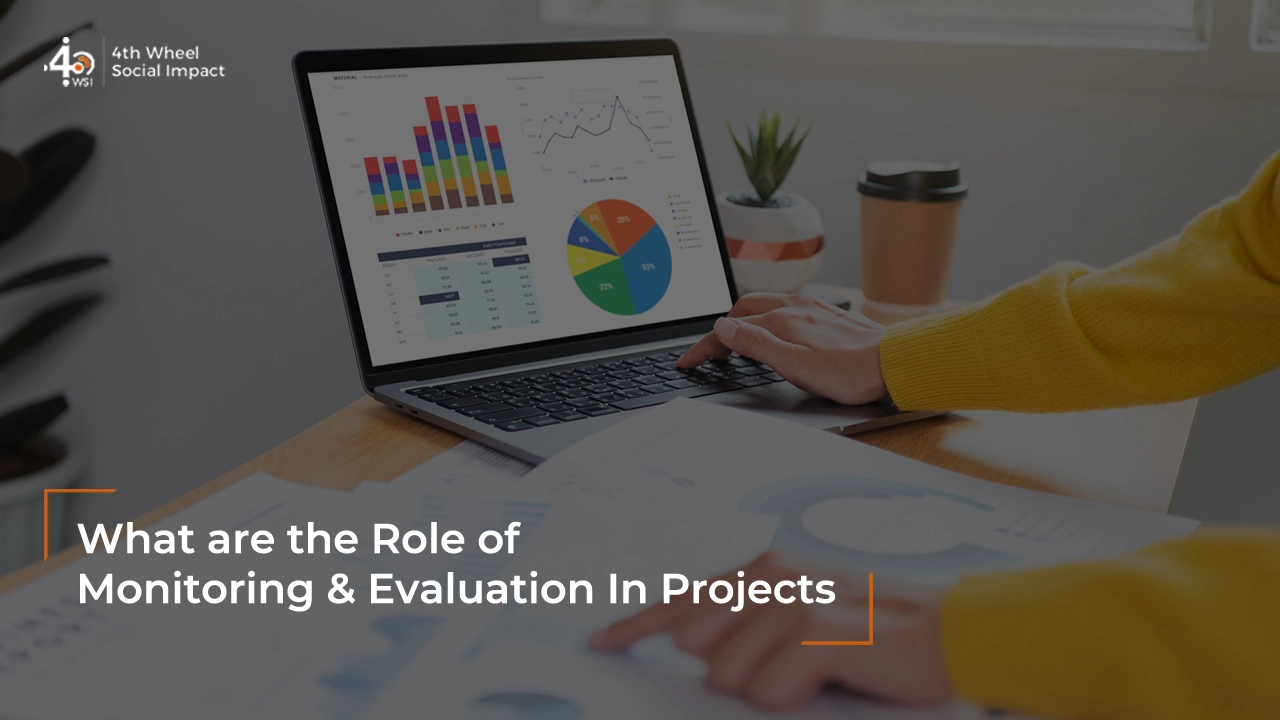Social impact organizations, along with other stakeholders such as corporate companies, have a responsibility to contribute to societal well-being. However, contribution alone is not enough. To truly increase both the depth and reach of impact, the changemaking process must continuously evolve and improve. This improvement can be driven by two key processes—monitoring and evaluation.
Imagine launching a project that aims to provide digital literacy training for underserved communities. You have the vision, the resources, and a passionate team. But how do you know if the program is truly making a difference? This is where project monitoring and evaluation (M&E) comes in—helping you track progress, measure impact, and adapt strategies for better results.
Monitoring is an ongoing process that provides real-time insights into what is happening within a program, whereas evaluation involves periodic assessments that track specific indicators related to program milestones. One of the primary role of monitoring and evaluation (M&E) is to offer both a detailed and a broader perspective on a program’s effectiveness.
What is Monitoring & Evaluation?
Monitoring primarily informs day-to-day management and decision-making. It tracks real-time data, such as administrative figures and short-term expected results. Continuous monitoring allows for trend analysis and helps assess program implementation milestones.
Evaluation, on the other hand, involves more structured assessments focused on program design, broader outcomes, and overall effectiveness. Unlike monitoring, evaluations are conducted at specific points in time and take a more objective, bird’s-eye view of a program’s impact.
Broadly, evaluations can address three types of questions:
- Descriptive questions: These aim to determine and describe processes, conditions, organizational relationships with various stakeholders, and their perspectives.
- Normative questions: These assess whether the program is achieving its intended outcomes by comparing actual results with expected goals. This comparison helps determine if activities are effectively driving progress.
- Cause-and-effect questions: These examine broader outcomes and assess the overall impact, analyzing the difference the program has made.
What Is the Role of Monitoring & Evaluation in Projects?

Monitoring and evaluation (M&E) play a vital role in social impact projects. It helps organizations assess both impact and implementation at every stage of a program. Below are some key functions of M&E:
Needs Assessment
Continuous monitoring and periodic evaluation help determine whether all community needs are being addressed. If a program falls short in meeting specific needs, M&E systems help identify these gaps. For instance, if an underprivileged school community requires translators, ongoing monitoring and evaluation can reveal why this is a core need and how students might benefit from fulfilling it. Over time, M&E studies also help assess how addressing this particular need contributes to the overall impact of the program.
Process and Implementation Evaluation
The success of any project depends on identifying the factors and outputs that drive progress. Social impact programs often involve multiple parallel processes, from stakeholder engagement to resource allocation. Monitoring these processes continuously and evaluating their effectiveness guarantees smooth implementation.
M&E helps identify bottlenecks, resource gaps, or necessary modifications in the implementation strategy. It also assesses stakeholder understanding of the program and evaluates their strategic role in the changemaking process.
Assessing Value and Outcomes
Monitoring helps determine whether activities and outputs are being utilized efficiently, whereas evaluation sees to it that they contribute to the program’s overall goals and outcomes. M&E examines:
- Whether outcomes are achieved within the expected timeline.
- Whether achieved outcomes align with the program’s broader goals.
- Whether the investment in activities and outcomes is yielding positive progress.
Additionally, M&E helps organizations allocate resources efficiently, set realistic goals, and measure success. It identifies both areas of success and potential shortcomings, allowing for timely adjustments to improve results.
Determining Long-Term Efficacy of Programs
M&E facilitates the comparison of results over time, helping organizations assess long-term efficacy and performance. By consistently measuring results, organizations can determine how well their initiatives are achieving intended goals and make data-driven improvements.
Impact Assessment
Beyond tracking outputs and immediate outcomes, M&E includes evaluation of a project’s broader impact on its target audience and community. This often requires a long-term perspective to understand the sustained effects of the program.
Why Monitoring & Evaluation Are Imperative for Project Success
Monitoring and evaluation (M&E) play an important role in ascertaining the success of projects in multiple ways. As one of the strongest pillars of project management, M&E drives initiatives toward their intended goal to create a meaningful and lasting impact. Below are key reasons why M&E contributes to a project’s success:
Minimizes the Risk of Project Failure
Continuous monitoring and evaluation help gather data, assess key outcomes, and track resource usage, implementation strategies, and multiple project processes. Since monitoring is ongoing, it provides avenues for early identification of obstacles, whereas evaluation focuses on refining long-term strategies. Together, they help projects stay on track and reduce risks of failure.
Without proper monitoring and evaluation, projects can quickly spiral out of control, leading to wasted resources and missed deadlines.
Supports Informed Decision-Making
M&E provides accurate and timely data. Through this pinpoint accuracy, it helps stakeholders make well-informed decisions regarding project implementation and necessary adjustments. By assessing stakeholder awareness and engagement, M&E makes sure that decisions are based on real-time insights, eventually increasing the chances of achieving the intended impact.
Strengthens Strategic Data Collection
M&E establishes structured data collection protocols and frameworks to deliver high-quality and reliable information for impact assessment. These strategic tools help refine research questions, improve data collection methods, and minimize errors so that decisions are based on strong evidence.
Validates the Theory of Change
The Theory of Change serves as a comprehensive roadmap for tracking a project’s progress and guiding its implementation from start to finish. Apart from the project plans and outcomes, the theory of change is also in need of evaluation and review. Monitoring and evaluation closely examine all aspects of the Theory of Change, including activities, outputs, intended outcomes, and overall impact.
M&E helps validate whether a project is following its intended Theory of Change. If deviations occur, it identifies necessary course corrections to realign the project with its intended impact.
Maintains Accountability
M&E provides an objective and detailed analysis of projects so that no critical factors are overlooked during documentation and assessment. With a strategic framework in place, M&E boosts transparency among stakeholders, fostering accountability in project execution and impact measurement.
Facilitates Learning from Successes and Challenges
Through continuous monitoring and periodic evaluations, M&E identifies key factors contributing to a project’s success as well as challenges that may arise along the way. This ongoing learning process serves as a roadmap for improving future projects, refining the Theory of Change, and proactively addressing potential challenges to strengthen overall project success.
Interesting reads: Evaluation in a Cultural Context: Insights for Better Practices
How to Implement Monitoring & Evaluation in Projects?

Project monitoring and evaluation is a detailed and structured process that involves multiple stakeholders. A well-implemented M&E plan helps track progress, measure impact, and refine strategies for better outcomes. Here’s an overview of key steps in an M&E plan:
Setting Clear Objectives and Indicators
The first step in M&E is to establish well-defined project objectives and measurable indicators. These indicators serve as benchmarks to track progress and assess success. For example, if a project aims to improve digital literacy, indicators could include the number of participants trained, improvements in digital skills, and job placements secured as a result of the training.
Planning Data Collection
Data forms the foundation of M&E. Throughout project implementation, data is collected using various methods such as surveys, interviews, focus groups, observations, and document reviews. This includes both quantitative data (e.g., numerical figures on program reach) and qualitative insights (e.g., participant experiences and feedback).
One of the key aspects of data collection is baseline data—information gathered at the start of the project to establish a point of reference. This baseline allows for meaningful comparisons over time, making it easier to measure progress and impact.
Analyzing Data for Insights
Once collected, data undergoes analysis to assess project performance. Data analysis involves statistical methods, qualitative assessments, or comparative studies to identify patterns and trends. A structured approach to data analysis makes findings reliable and actionable.
For example, if an M&E study finds that fewer women are completing a vocational training program, further analysis may reveal underlying challenges, such as scheduling conflicts or childcare responsibilities. Identifying these gaps allows for targeted improvements.
Reporting and Feedback
M&E findings are compiled into reports that offer valuable insights into what is working well and what needs improvement. These reports help inform decision-making at all levels—whether for internal program adjustments or for external stakeholders such as funders and partners.
Regular reporting supports transparency and accountability. It also allows organizations to demonstrate their impact. Feedback from these reports can lead to real-time adaptations in program design and implementation.
Learning and Adaptation
M&E is not just about tracking outcomes—it also facilitates continuous learning and improvement. By regularly assessing project effectiveness, organizations can make data-driven decisions, refine their strategies, and improve long-term impact.
For instance, if monitoring data shows that a mentoring program for students is having a positive impact but lacks long-term engagement, an evaluation can suggest ways to strengthen follow-up support. This adaptive approach sees to it that projects remain relevant and responsive to community needs.
What are the Common Challenges and Solutions in M&E?
Monitoring and evaluation (M&E) is critical for tracking progress and impact in social impact projects. And yet, many organizations face common challenges in monitoring and evaluation assessments. Here are some key hurdles and ways to overcome them:
Measuring Impact, Not Just Numbers
Many M&E systems focus on what was done rather than what changed. While numbers indicate that activities took place, they don’t necessarily show whether those activities made a real difference. For example, tracking the number of workshops held doesn’t reveal whether participants actually learned something valuable or applied that knowledge.
Solution: Conceptualize a plan that tracks both activities and outcomes. Each time you list an activity, ask: So what? Keep asking until you reach a meaningful impact. For instance, instead of just counting training sessions, measure whether participants gained new skills, changed behaviors, or improved their livelihoods.
Over-Reliance on Donor Guidelines
Since most projects depend on donor funding, reporting progress according to donor expectations is a necessity. But strictly following donor procedures without flexibility can sometimes hinder meaningful M&E. It can lead to monitoring strategies that prioritize funder requirements over community needs, limiting the ability to make necessary course corrections.
Solution: Develop an approach that integrates donor guidelines that also evaluates their effectiveness for the project. If certain guidelines aren’t working, be prepared with alternatives backed by data and tested strategies. Proactively include suggestions and findings in donor communications to make sure both funders and communities benefit.
Neglecting Qualitative Data
Numbers alone rarely tell the full story. Many M&E systems focus heavily on quantitative data because it provides measurable results such as how many people attended a training program or how many resources were distributed. Nevertheless, overlooking qualitative insights such as participant experiences, challenges faced, and real-world impact can lead to an incomplete assessment.
Solution: Use a mixed-methods approach that balances both quantitative and qualitative data. Incorporate interviews, focus groups, and case studies to provide context and deeper understanding. Clearly outline in your M&E plan how qualitative data will answer critical questions, such as Why did a program succeed or fail? or What unexpected challenges emerged? These insights make M&E findings more actionable and relevant.
Not Using M&E Findings for Decision-Making
One of the most significant mistakes in M&E is collecting valuable data but failing to use it effectively. Monitoring and evaluation should not just be a reporting exercise—it should drive continuous learning and improvement. If findings are not used to inform project decisions, the entire effort becomes redundant.
Solution: Develop a structured process to act on M&E findings. Establish clear feedback loops where insights from M&E are discussed with key stakeholders and used to refine strategies. Build mechanisms for sharing lessons learned, adjusting project approaches, and ensuring that future actions are guided by evidence.
Interesting Reads: Top 3 Anthropology’s Practices in Monitoring & Evaluation
Future of Monitoring & Evaluation
Embracing Complexity
Development is rarely linear and unexpected challenges and shifts are inevitable. M&E is evolving to keep up with the unpredictable nature of social impact work. Gone are the days when M&E followed a rigid, one-size-fits-all structure. Today, monitoring and evaluation are adapting to the spontaneity of projects and the shifting challenges they address. With increasingly complex social issues, M&E must go beyond surface-level assessments and tackle deeper, more nuanced questions.
Real-Time Data and Technological Integration
Technology has reshaped nearly every aspect of our lives, and M&E is no exception. The growing demand for agile decision-making and proactive program adjustments has made real-time data tracking an indispensable task. Digital tools and AI-driven insights are transforming how organizations monitor progress, identify gaps, and pivot strategies—making M&E faster, smarter, and more responsive.
Focus on Equity and Inclusion
The social impact sector is recognizing that including marginalized communities isn’t just beneficial—it’s non-negotiable for sustainable change. Traditionally, M&E was often conducted by external consultants with little direct engagement from the communities impacted. But now that’s shifting. More organizations are integrating local voices into data collection and decision-making to make sure that insights aren’t just extracted but also contribute to meaningful, community-led impact.
Examples of Monitoring and Evaluation in Project Success

TESCO, in collaboration with Samarthanam Trust for the Disabled and The 4th Wheel Social Impact, launched Project ReWare in Bangalore to tackle urban waste management challenges and reduce landfill waste through community participation, training programs, and stakeholder partnerships.
One of the key challenges identified was the lack of a Monitoring, Evaluation, and Learning (MEAL) framework that made it difficult to track progress and assess impact. To address this, 4th Wheel Social Impact facilitated the implementation of a structured MEAL approach, aligned with a Theory of Change framework, to define key performance indicators and measure outcomes.
By digitizing data collection through SurveyCTO and integrating both qualitative and quantitative tools, the team incorporated more accurate tracking of behavioral changes in waste management practices.
Through this engagement, Project ReWare successfully transitioned from an awareness-driven initiative to a data-backed and impact-focused model.
Conclusion
Monitoring and Evaluation (M&E) is more than just a process—it’s the backbone of impactful and sustainable development. In a fast evolving world, where social challenges are complex and ever-changing, nonprofits and social impact organizations must go beyond intuition and good intentions. Project monitoring and evaluation are not just support functions—they are key drivers of meaningful and sustainable impact.
If you too, want to assess where your organization stands in its Monitoring & Evaluation (M&E) journey and identify areas for improvement, take our interactive M&E quiz: Start the Quiz. To know more about our services and our offerings for monitoring and evaluation studies, get in touch with us.




